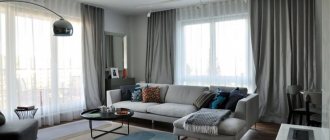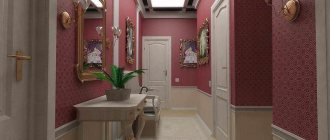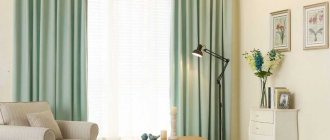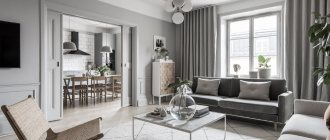The basic gray color scheme in the interior is neutral. It is easy to combine with both pastel and bright shades. When choosing the main palette in the design of a room, it is necessary to take into account several factors, including the saturation of gray and its undertone.
Gray color always means nobility and sophistication, which are valued in any home.
Psychology of gray
Gray color is obtained by mixing black and white. Depending on the intensity, it can be used either as a background tone or as a main color accent.
The gray palette gives the room nobility and elegance. It does not cause tiredness and tiredness; on the contrary, graphite tones contribute to a high quality of rest. At the same time, shades of gray open up wide scope for design imagination, including regarding textiles.
Recommendations from professionals: methods for combining shades
A stylish and cohesive kitchen interior requires the right combination of basic tone and colored elements. This is especially true for textiles. The kitchen can have a sofa or chair decorated with pillows. The window opening, and sometimes the door, is also decorated with fabric (tulle, curtains, blinds or textile drapery), and on the table or furniture - napkins, towels, potholders. All fabric elements must be combined and form a single composition.
To do this, you need to take into account the rules that have long been known to artists and designers.
One of the brightest and most energetic combinations is the use of two contrasting (complementary) shades. This interior looks especially vibrant with maximum color saturation.
Using a three-color combination of shades located at the same distance from each other will enliven the interior even when using desaturated, pale options.
The interior looks great if several shades are used (no more than 5, preferably 3). They should be similar and located next to each other. For example: pale shades of yellow-orange, yellow, yellow-green, green, blue-green.
Choosing curtains for gray wallpaper
A simple and understated palette will pair well with a variety of colors, from pastel to bold. Textiles allow you to add variety to an anthracite interior. By choosing the right curtains for gray wallpaper, you can solve a number of problems:
- add lightness to the room;
- highlight functional areas;
- add a touch of homely warmth.
Specifics and nuances
What curtains go with gray wallpaper? This question occupies many people. A variety of tones will look great against a neutral background. But when deciding on the range, it is necessary to take into account several factors.
In order not to make a mistake in choosing the color of the curtains, you need to start by determining the main shade of the walls. Each gray has its own tone - warm or cold.
The first one is red or yellow, the second one is blue or cyan. Taking this into account, the colors of the curtains are selected. Warm gray colors are complemented by textiles of the appropriate warm tones, while cold ones require the use of curtains in cold tones.
Blue
Blue color in combination with gray gives the room a calm nobility. This combination is pleasing to the eye and does not create sharp contrasts.
The use of blue curtains is determined by its contrast - the darker the color, the more severity it adds.
Therefore, blue curtains should be used in the bedroom, dark blue and desaturated blue curtains in the living room, and dark blue curtains are a good choice for the office.
Kitchen
Here, the gray palette is often used in styles such as high-tech and Provence. If a metallic or dark gray shade is chosen to decorate a kitchen location in the avant-garde style, then the window should be decorated with a white tulle curtain without ornaments or additional decor.
Country style welcomes curtains with draperies, frills, and patterns.
Choosing material
The appearance of the curtains depends on the material made, so the choice of fabric is a very important point in creating the atmospheric composition of the room. To make the right choice, you need to consider several important factors:
- When choosing fabric density, be sure to consider how intense the sun's light enters the room. In dark rooms, it is worth hanging curtains made of light transparent textiles so that they transmit natural light as best as possible;
- For sunny rooms, gray curtains made of heavy material would be an excellent option. They will not only protect you from the sun, but will protect the room from overheating;
- When choosing material for curtains, take into account the style features in the interior of the room;
- You also need to take a closer look at the texture of the fabric. After all, not everyone prefers shiny curtains that reflect color. And some people won’t like matte curtains, which, on the contrary, absorb light;
- You also need to consider the practicality of the fabric. How does it wash, is it difficult to remove stains from it, what is its resistance to sunlight and various other factors.
If you like thicker fabrics and are completely sure that they will suit your guest room, then choose from taffeta, tapestry, velvet and velor. For light curtains in a living room with poor lighting, use organza, muslin or guipure.
Please note that fabric density has an impact on color perception! The higher the density of the fabric, the darker the gray color appears, even if the curtain of the lightest colors hangs on the window.
Bedroom
The decor of this room should be conducive to rest and relaxation. To go with light gray wallpaper, it is advisable to buy curtains in smoky or graphite colors and snow-white curtains. You can dilute the gloom of a dark finish with milky white tulle.
Here are a few subtleties on how to choose curtains for a bedroom if its area leaves much to be desired:
- The preferred type of fastening is a ceiling-type cornice.
- Textiles in light and white tones will suit any shade of gray.
- You should not hang dark curtains in a compact room.
- Light tulle in a light palette will visually expand the size of the room.
Let's consider several color solutions
Gray is a rather complex color. Therefore, combining it with other tones must be approached very carefully. In the classic version of using this color in the design of living rooms, a gray and white theme is used. White will add freshness and liven up a sad gray color and help it show off new shades. You just need to take into account a small note - it is better to use not snow-white color, but white with yellow or off-white. These shades will not create too much contrast, but rather will be a good additional background for the gray color.
Warm and rich shades of curtains
Among these shades, designers highlight pink, peach, and yellow. These colors will dilute the gray shades of the living room, give the room some delicate and soft colors, and also make the guest room lighter and more comfortable. The design of curtains in such shades is not too deep, but at the same time it is quite not boring and playful.
Blue, lilac, soft green tones
Curtains in lilac and blue tones will fit especially well into the interior of the living room, which is located on the south side. This will help visually reduce the excess sun, as well as make the atmosphere in the room more calm. And pillows matching the color of the curtains will help the living room look perfect!
The soft green shade of the curtains when combined with the gray interior will provide you with an amazingly relaxing atmosphere. After all, green is not a contrasting color at all, but despite this, it perfectly highlights the gray tones in the interior.
Curtains in neutral colors
If you are very afraid of making a mistake with a color, then there is the safest and win-win option for you - curtains in nondescript shades. You definitely won't have any problems with them. Any tones, for example:
- sand;
- coffee;
- cream or beige.
These colors will fit perfectly and diversify a gray interior. With curtains of the listed colors you will get a stylish and calm decor. Another simple option for curtains in the living room is a combination of several tones of gray in the interior.
Gray curtains are an organic addition to gray walls. In this case, you need to use different tones of gray, for example, buy curtains several tones lighter than the walls, or hang curtains with a pattern in the color of the floor or furniture.











